© Borgis - New Medicine 1/2010, s. 29-35
*Timea Tóth, Judit Mészáros
Drawing Value Profiles for Young Hungarians Selecting Careers in the Helping Professions
Head: Dr. Judit Mészáros, Dean, College Professor, Candidate of Pedagogic Studies
Summary
The aim of this study involving 255 elements is to map the value attitudes of young people selecting paramedic careers from an emotional aspect – by applying the method of Osgood's semantic differential scale. By using connotations related to the four value concepts and themselves (ego, helpfulness, creativity, freedom, cooperation), a multidimensional value assessment was performed on two samples (2003 and 2007). As a result, students in both target groups considered helpfulness to be the most valuable ability, and this resonates with the societal expectations for those wishing to make commitments to the helping professions. The most important conclusion is that the 18–26-year-old students polled consider themselves to be the least valuable, and this surprising result has definitely an indicative value and represents important feedback on the self-evaluation of young people entering higher education.
Aim
The aim of the assessment performed among students is the examination of starting value profiles and value attitudes of young people selecting careers in the helping professions. In the case of professionals practising helping professions – in comparison with general public thinking – the representation, conveyance and display of certain human values is of elemental importance, since the fine-tuning of personality as a „work tool” may also start with a person's own value orientation. In my opinion, a great deal depends on how the emotional relationships of persons with human values are characterized, especially if they select careers in the helping professions.
On one hand, the values and the view of humans of the future helper may affect the quality and success of the helping activity; thus, the work of the helping professionals is influenced by their view of life, the internal emotional world which determines their opinion about others, human nature, whatever they assume about themselves and their fellow human beings, their behaviour and attitudes. For example, in the case of persons selecting „helping” professions, it represents a great difference what kind of values they view in cooperation or how they prefer helpfulness or, as persons engaged in health development, what their attitudes and set of values are in their relationships to themselves and their future patients (1).
The tested target group is composed of 18-26-year-olds. This life stage is highly dominant from the aspect of an established value consciousness. Developmental psychology and andragogy considers this life phase as the period of young adulthood, and principal characteristics of developmental psychology, possible sources of success or crisis in this period of life must be definitely borne in mind, since the ( value-related) ideas, impressions and attitudes of young people having just started their higher education studies can be strongly influenced by a regular pattern in andragogy according to which a type of „regime change” takes place around the age of 18-20 in terms of the socialization and life path of the individual, and this may even give rise to a temporary crisis or vacuum of values in this cycle of self-trial (2).
The concept of value is considered by nearly all social sciences (and a good many natural or economic sciences) as their own, even if the concept is basically of a philosophical, metaphysical nature. We can only refer to values in the original sense of the word if a valid reference basis is available in comparison with which something can be regarded as valuable. However, it can be readily acknowledged that every human action is a type of decision, a type of satisfaction of needs and, simultaneously, a selection of values between different alternatives. The concept is determined by selecting one from the value definitions: „Values are objectivations of ideas. They accumulate those aspects of human experience and knowledge which are related to their direct societal existence and this is closely connected apart from rational thinking to their emotional emphasis, the qualifications of the given culture and society.”(3)
Material and methods
The tested sample is composed of two parts: the first, earlier sample was selected among full-time students with a nursing major attending the Faculty of Health Sciences in the academic year of 2003/2004, with 105 elements and by random sampling, representing 42.7% of the student population. The second, later sample was composed by random selection of full-time students majoring in Nursing and Patient Care, and 150 persons completed the questionnaire in a manner suitable for evaluation, representing 57.5% of the statistical total.
The semantic differential used by me is a special form of attitude measurement, a well-known and frequently used procedure of researching emotional fields of meaning. It was worked out by C. Osgood (1957, 4, 5), who started to elaborate his measurement system in the mid-fifties. This test was developed as a counterpoint to summarizing scales, and it can be regarded as a multidimensional measurement process. Osgood's attention was caught by the fact that in everyday life, words are located at three levels of semantics: the denotative level shows objective notation, the connotative level is an emotional-evaluating dimension, which can be personal and symbolic, as well, and the associative aspect is the linking of words and concepts with other ones. Here, the connotative dimension (referring to a specific relationship) has a special role, since it reflects the originally evaluative character of everyday thinking and fulfils the function of organizing reality via the relationship of valuThrough the use of the test, the differences between connotations of given persons linked to words, values, persons and phenomena can be detected, by which the psychological „distance” of concepts can be established. Thus, semantic differential denotes the difference in meaning, and it is a method of analysing words and concepts in which those concepts are associated with contrary attributes (e.g. good–bad, pleasant–unpleasant, strong–weak). Contrasting (bipolar) attributes are located at the two ends of a six-level scale and the subjects have to place the subject somewhere on the scale between the two contrasting attributes, which will indicate the connotative meaning of the concept.
After data processing, the researcher can draw a semantic curve, i.e. a value profile in which the connotations of the interview participants associated with the given word can be elucidated. In the course of my investigation, I asked questions regarding the following value concepts:
– EGO
– HELPFULNESS
– FREEDOM
– CREATIVITY
– COOPERATION
By using factor analysis, Osgood further showed that in the present study, the emotional relationship of words with values can be shown in terms of three factors: in the dimensions of force, activity, and value, respectively. Thus, this measurement procedure provides an opportunity to simultaneously and empirically handle impressions related to several attitude objects in the multidimensional, so-called semantic space.
The following attribute pairs are included in the force factor:
– decisive–indecisive, difficult–easy, strict–lenient, strong–weak, masculine–feminine, sharp–blunt.
Activity has the following value factor attributes:
– active–passive, soft–hard, languishing–persisting, warm–cold, fast–slow, relaxed–excited.
The value factor evaluation has the following components:
– good–bad, optimistic–pessimistic, clean–dirty, harmful–useful, ugly–beautiful, false–true.
The limitations of this assessment include that standard deviation should be taken into account as well when analyzing value profiles, since we have to face the so-called zero point problem when interpreting the Osgood scale: since the central or median elements of the scale may equally represent lack of opinion, caution, indecisiveness, indifference, or neutrality. Therefore, the application of the scale, reliability and information value of recorded data greatly depend on data spread.
The following statistical results were used in the course of the analysis by the software SPSS and the data were expressed in a three-dimensional coordinate system, and in a value profile in a radar diagram.
Results
The group-level arithmetic averages (results) of two-sample connotations related to the value concepts are depicted in the following radar diagrams. The internal end-points of the seven-level scales are classified in the 17 attribute pairs from the extreme values of weak, passive and worthless to the qualifications of strong, active and valuable. The inner circle depicts the zero point.
The diagram image of the two samples shows that students primarily considered themselves to be „good”, „clean” and in 2003, somewhat „more true” (fig. 1). The interview participants also considered the „optimist”, „decisive” and „useful” attributes as fairly characteristic of them. The human quality characteristics of „lenient”, „soft” and „relaxed” were placed around the medium value (0). Moreover, the students considered themselves as „lenient”, „fast”, „decisive” and „active” rather than „strict”, „slow”, „passive” or „indecisive”.
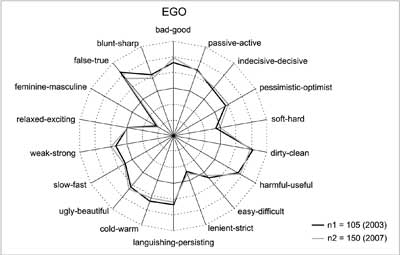
Fig. 1.
In evaluation of the relevant concepts, responders nearly equally considered HELPFULNESS (fig. 2) to be „good”, „active” and „useful”. Moreover, the attributes „clean”, „true”, „decisive” and „beautiful” had high average values, as well. On the scale „softness–hardness” and „leniency–strictness”, results were close to zero, relatively neutral. Both student groups considered this value and ability to be rather „relaxed” and „feminine”.
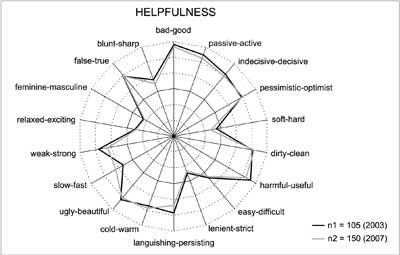
Fig. 2.
A detectable difference can be shown between the averages of the two samples in the „weak–strong”, „slow–fast” and „languishing–persisting” dimensions. The young interview subjects felt that HELPFULNESS could be linked to „bluntness” and „warmth” rather than „sharpness” or „coldness”.
The value concept of FREEDOM (fig. 3) achieved high group averages in both samples in the qualifications of „good”, „active”, „optimist”, „clean” and „useful”. In 2003, FREEDOM was considered a somewhat „slower” character, whereas in 2007 it was described by students as „blunter”. The scales of the attribute pairs „lenient–strict”, „soft–hard”, „feminine–masculine” include values close to zero, although the target group tested earlier considered this value as somewhat more „masculine”. For young people, FREEDOM is a „persisting” rather than „languishing” and a „strong” rather than „weak” value concept.
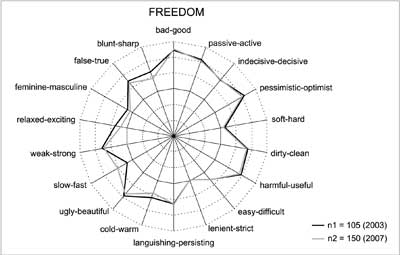
Fig. 3.
Students interviewed in 2007 considered CREATIVITY (fig. 4) to be somewhat „more relaxed”, „faster” and „uglier” than responders in the earlier sample. Both student target groups assessed the value concept to be fairly „good”, „active” and „useful”, respectively, and a high score average can be observed on the scales of „optimism”, „decisiveness” and „activity”, as well. Moreover, they considered this concept as „lenient” rather than „strict”, „true” rather than „false” and „feminine” rather than „masculine”. In the dimension „softness–hardness”, the attitude to CREATIVITY was characterized by neutrality.
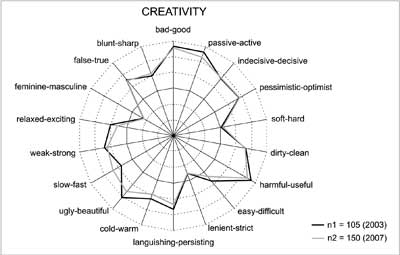
Fig. 4.
In the COOPERATION (fig. 5) value scale, no great difference can be detected between the average scores of the two samples. Some visible difference is manifest between the results in the value pairs of „easy–difficult” and „ugly–beautiful”. Both groups gave high average scores in the qualifications of „good”, „useful”, „active” and „decisive”. Responding students tended to assign this value to „femininity”, „fastness” and „optimism”. The relationship to the COOPERATION concept delivered roughly similar results in the qualifications of „weak–strong”, „languishing–persisting” and „false–true”.
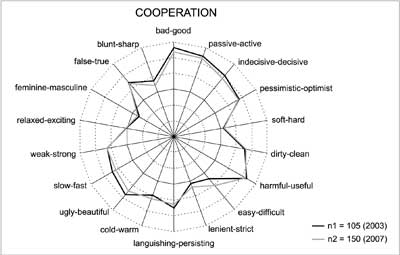
Fig. 5.
In the spatial depiction of the three factors (activity, force, evaluation), the mutual spatial distances of value concepts are readily visible. Concepts are visibly located in a well-delineated group. The evaluation of „ego” and freedom are located far away and the concepts of „creativity” and „cooperation” are located rather closely. In the WEAK–STRONG dimension, students responding in 2003 considered the „ego” to be the weakest while „freedom” ended up being the strongest. In the coordinates of PASSIVITY–ACTIVITY, the two extreme average values are represented by „helpfulness” and „ego”, respectively. In the VALUABLE–WORTHLESS factor, the lowest average value was assigned by „ego”, closely followed by „helpfulness”.
In the WEAK–STRONG factor, the „helpfulness” factor received the lowest average value while „cooperation” seemed to be the strongest value category for students. Similarly to the data in 2003, the evaluation of the „ego” had the lowest average along with PASSIVITY–ACTIVITY, and students considered „creativity” to be the „most active” value category in 2007, as well.
In this later sample, responders considered „helpfulness” to be the most valuable and this was identical to the result drawn along the WORTHLESS–VALUABLE axis of 2003. Even in this sample, the interviewed students considered themselves to be the least VALUABLE. Moreover, in 2007, the evaluation of the „EGO” reached an even longer average value in comparison with the results in 2003.
Discussion
On the basis of the results, we can establish the following:
– an indicative difference worthy of emphasis between the value profile curves of the two samples can be detected in the slow–fast evaluation of „helpfulness”, „freedom”, the ugly–beautiful scale of the value „cooperation”, and the harmful–useful and weak–strong axes of „helpfulness”;
– a difference is also manifest between the group averages seen on the false–true and bad–good scales, considering „ego”-related connotations, i.e. students considered themselves less true but better than in 2007;
– in the semantic space, the concept and value of „helpfulness” was shifted the most spectacularly between the samples of the two years; the later target group (2007) associated this ability with weakness rather than strength – this can be explained by the phenomenon of increased significance of postmodern and individualist values in the whole society;
– surprisingly, in the valuable–worthless factor, students considered themselves, the „ego”, to be the least valuable, which presumably may be related to the lack of societal prestige of paramedic professions;
– in the valuable–worthless axis, the position of cooperation slid back somewhat in the later sample, i.e. the students interviewed later considered this ability to be a less preferred value, which is not too positive as feedback regarding the values of young people selecting careers in the helping professions;
– creativity largely maintained its position on all three axes, which indicates that both student samples have a similar value awareness of this activity, which is indispensable for this profession.

Fig. 6. Location of value concepts in semantic space 2003, n=105.
3 factors: x,y,z axes
x: weak–strong
y: passive–active
z: worthless–valuable
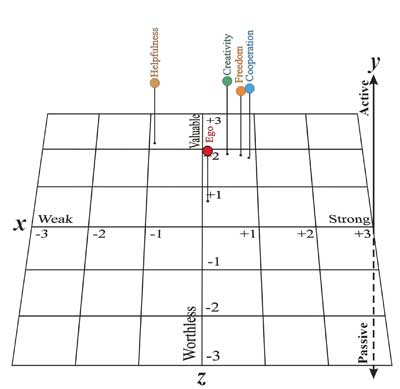
Fig. 7. Location of value concepts in semantic space, 2007 n=150.
3 factors: x,y,z axes
x: weak–strong
y: passive–active
z: worthless–valuable
Conclusion
On the basis of the above, we can confirm that no difference can be detected between student samples in the two years, and in their emotional relationship to values, they considered „helpfulness”, which is one of the most essential values with regard to career identification, to be the most valuable. And indeed, the presence of an altruistic attitude is indispensable for young people dedicated to the helping professions. On the other hand, disturbances of self-assessment and self-respect are strongly characteristic of the examined target groups, and in education this phenomenon is definitely worthy of attention.
The research project could be perspectivic and long term to the extent that – by adding further human value categories to the investigation – it could be extended to a multi-sample, highly informative and exciting comparative assessment in which value profiles could be drawn of students with different professional ideas (preparing for business, engineering or artistic careers). Thus, the research of value could be linked to youth research, and in doing so, a whole generation could reflect a layer of societal reality regarding value attitudes, since „if we address values per se, we can hope to clarify some other factors, as well. We can learn more about human beings, society and the driving forces of present history” (6).
Piśmiennictwo
1. Bagdy E: Az emberi kapcsolatok dinamikája. In: Tanulmányok a vallás és lélektan határterületéről. ed. Jelenits I., Tomcsányi T. SE - TF Mentálhigiénés Tanszék, Párbeszéd Alapítvány Bp 2003. 2. Erikson EH: Identifikáció és identitásed. Kósa É. Ritoókné Ádám M. Fejlődéslélektan Szöveggyűjtemény. Tankönyvkiadó Bp 1990. 3. Erikson EH: Az emberi életciklus. In: Bernáth L., Solymosi K. (ed.) Fejlődéslélektan. Olvasókönyv Tertia Bp 1997. 4. Bugán A: Érték és viselkedés. Akadémiai Bp 1994. pp. 36. 5. Osgood CE, Suci GJ: Tannebaum. The mesurement of meaning. Urbana: University of Illinois Press 1957. 6. Ajzen I: Attitudes, personality and behavior. McGraw-Hill International. 2005. 7. Szokolszky Á: Kutatómunka a pszichológiában. Osiris Bp 2004. 8. N. Kollár É, Szabó É (ed.): Pszichológia pedagógusoknak. Osiris Bp 2004. 9. Tóth T: Szolidaritás vagy önérvényesítés? Paramedikális hivatást választott fiatalok érték-prioritásai. Nővér 2009; 22(3): 17-25. 10. Varga K (ed.): Értékek fénykörében. Akadémiai Bp 2003. pp. 17.






